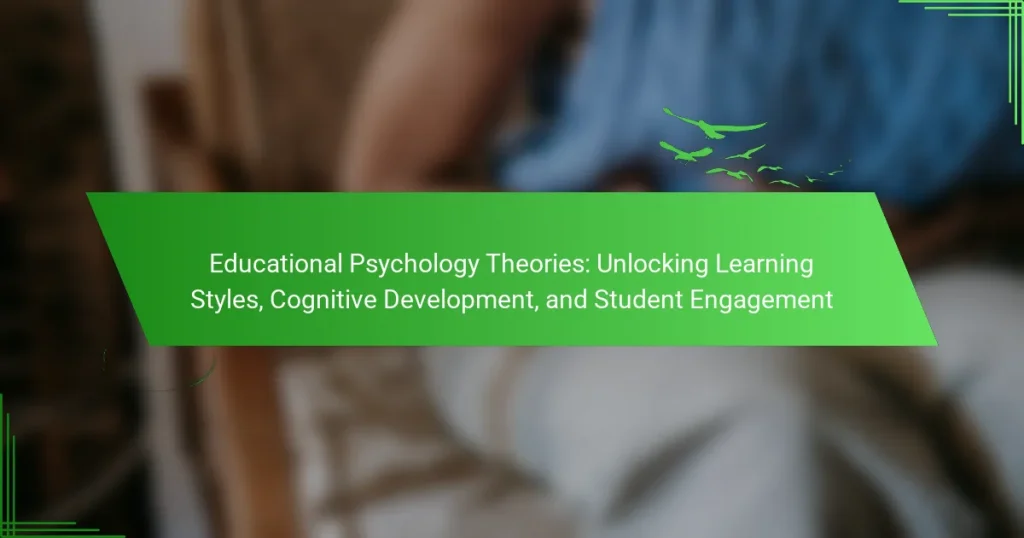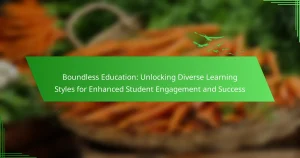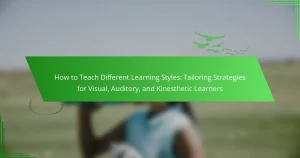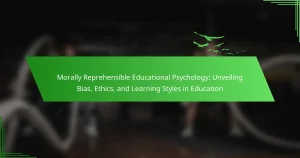Understanding educational psychology theories can significantly enhance student learning experiences. This article explores key theories like Behaviourism and Cognitivism, examines effective learning styles, and highlights rare attributes that boost student engagement. Strategies for fostering participation and catering to diverse cognitive needs will also be discussed. Emphasising evidence-based practices is essential for optimising educational outcomes.

What are the key theories in Educational Psychology?
Educational Psychology encompasses several key theories that enhance understanding of learning processes. Prominent theories include Behaviourism, which focuses on observable behaviours; Cognitivism, emphasising mental processes; Constructivism, highlighting knowledge construction; and Social Learning Theory, which incorporates social context in learning. Each theory offers unique insights into student engagement and cognitive development, shaping educational practices and strategies.
How do learning styles influence educational outcomes?
Learning styles significantly influence educational outcomes by tailoring teaching methods to individual preferences. Research shows that students who engage with their preferred learning styles exhibit higher retention rates and improved academic performance. For instance, visual learners benefit from diagrams and charts, while auditory learners excel with lectures and discussions. Adapting educational strategies to these styles can enhance cognitive development and increase student engagement, leading to a more effective learning environment.
What role does cognitive development play in learning?
Cognitive development is crucial in learning as it influences how students process information and engage with content. This development shapes critical thinking, problem-solving skills, and the ability to understand complex concepts. For example, Piaget’s theory highlights stages of cognitive growth that affect learning styles. As a result, educators can tailor teaching methods to align with students’ cognitive capabilities, enhancing engagement and retention. Understanding cognitive development allows for effective strategies that cater to diverse learning needs.
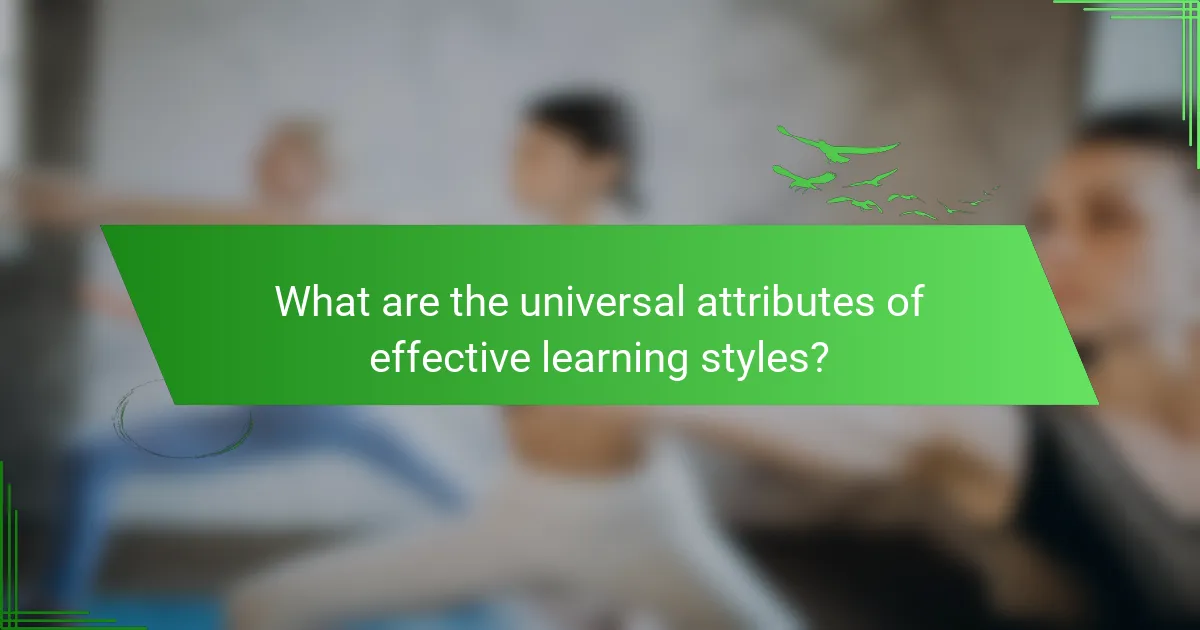
What are the universal attributes of effective learning styles?
Effective learning styles share universal attributes that enhance cognitive development and student engagement. These attributes include adaptability, which allows learners to adjust approaches based on context; active participation, fostering deeper understanding; and personalisation, tailoring methods to individual needs. Additionally, collaboration promotes social learning, while feedback mechanisms support continuous improvement. Each attribute contributes uniquely to effective learning experiences.
How do visual, auditory, and kinesthetic learners differ?
Visual, auditory, and kinesthetic learners differ in their preferred methods of acquiring information. Visual learners benefit from diagrams and charts, auditory learners excel with spoken information, and kinesthetic learners thrive through hands-on activities.
| Learning Style | Primary Mode of Learning | Example Techniques |
|——————|———————————|—————————————|
| Visual | Visual aids | Diagrams, videos, charts |
| Auditory | Listening | Lectures, discussions, audiobooks |
| Kinesthetic | Physical engagement | Experiments, role-playing, simulations |
What are the benefits of identifying learning styles?
Identifying learning styles enhances educational outcomes by tailoring teaching methods to individual needs. This approach fosters deeper engagement, improves retention, and promotes self-directed learning. For instance, students who understand their preferred learning style can employ strategies that align with it, leading to increased motivation and academic success. Research shows that personalised learning experiences significantly boost student performance and satisfaction, making the identification of learning styles a valuable tool in educational psychology.
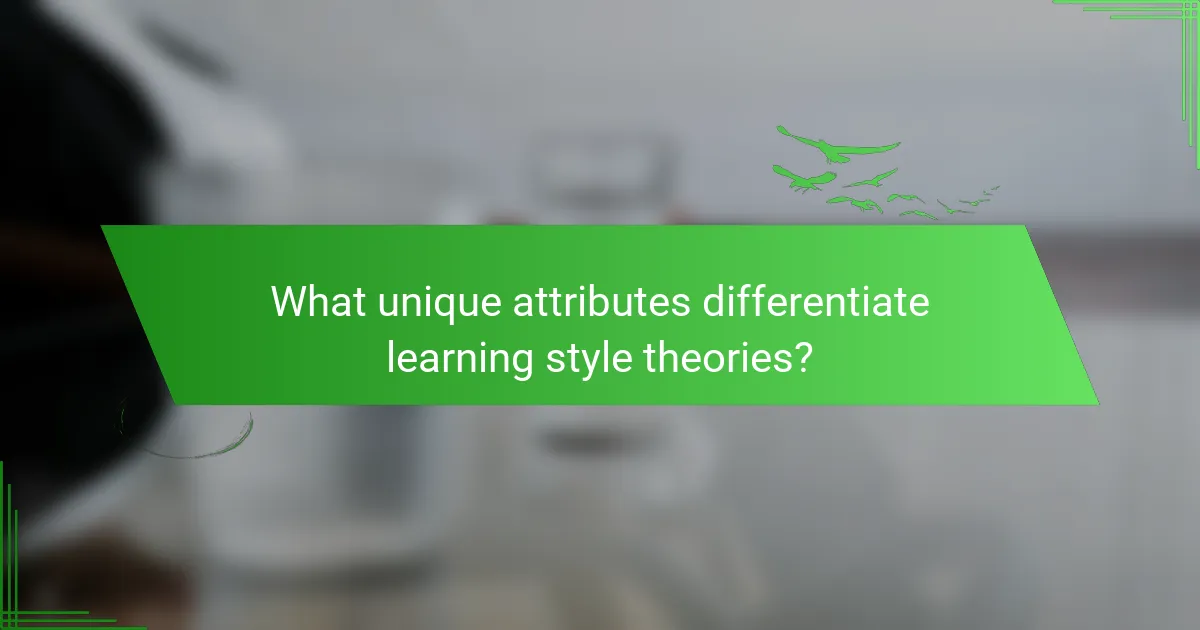
What unique attributes differentiate learning style theories?
Learning style theories differ through unique attributes such as sensory modalities, cognitive processes, and individual preferences. These aspects influence how learners engage with material and retain information. For instance, some theories emphasise visual learning, while others focus on auditory or kinesthetic approaches. Each theory provides insights into tailoring educational experiences for diverse student needs.
How does Gardner’s Theory of Multiple Intelligences apply to learning styles?
Gardner’s Theory of Multiple Intelligences emphasises that individuals learn in diverse ways, impacting educational approaches. This theory identifies various intelligences, such as linguistic, logical-mathematical, and spatial, each influencing unique learning styles. For example, a student with strong spatial intelligence may excel in visual learning activities, while one with linguistic intelligence may prefer reading and writing tasks. Educators can enhance engagement by tailoring instruction to these intelligences, fostering a more inclusive learning environment. Understanding these differences allows for personalised learning experiences that cater to students’ strengths, ultimately improving cognitive development and academic success.
What is the significance of Kolb’s Learning Styles Model?
Kolb’s Learning Styles Model is significant because it enhances understanding of diverse learning preferences. This model categorises learners into four styles: converging, diverging, assimilating, and accommodating. Each style influences how students engage with material and interact in educational settings. Recognising these styles allows educators to tailor their approaches, improving student engagement and cognitive development. This personalised learning environment fosters deeper comprehension and retention, ultimately leading to more effective educational outcomes.

What rare attributes influence student engagement?
Rare attributes influencing student engagement include intrinsic motivation, sense of belonging, and personalised feedback. Intrinsic motivation enhances learning by fostering curiosity and enjoyment. A sense of belonging creates a supportive environment, encouraging participation. Personalised feedback helps students understand their progress and areas for improvement, increasing their investment in learning. These attributes are crucial for developing effective educational strategies.
How do emotional factors affect learning styles?
Emotional factors significantly influence learning styles by affecting motivation, engagement, and retention. Positive emotions enhance cognitive development, while negative emotions can hinder learning. Understanding this relationship helps educators tailor approaches to meet diverse student needs. For instance, students with high emotional intelligence often adapt their learning styles more effectively, demonstrating a unique attribute that enhances their educational experience.
What impact does cultural background have on learning preferences?
Cultural background significantly influences learning preferences by shaping how individuals process information. For instance, collectivist cultures may prioritise group learning, while individualistic cultures often favour independent study. Studies indicate that cultural context affects motivation, communication styles, and cognitive approaches. Understanding these differences enhances educational strategies and improves student engagement.
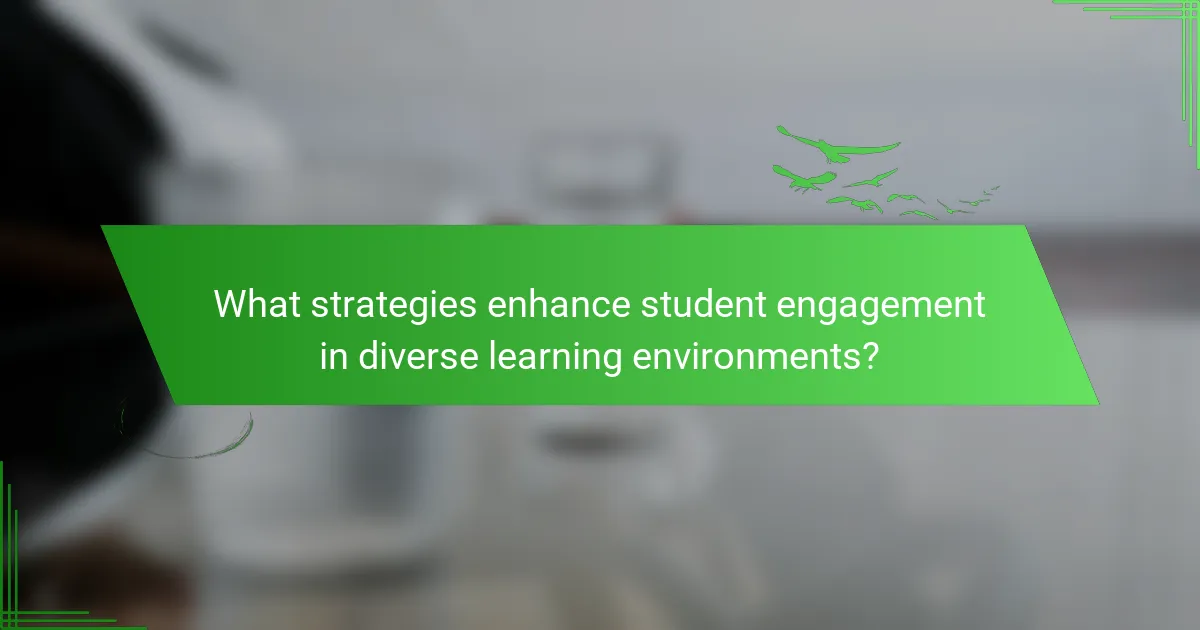
What strategies enhance student engagement in diverse learning environments?
To enhance student engagement in diverse learning environments, strategies must cater to varied learning styles and cognitive development. Active learning techniques, such as collaborative projects and discussions, foster participation. Differentiated instruction, which tailors content to individual needs, promotes inclusion. Utilising technology, like interactive tools, can also boost engagement by making learning more dynamic. Formative assessments provide feedback, encouraging students to take ownership of their learning.
How can educators adapt teaching methods to various learning styles?
Educators can adapt teaching methods to various learning styles by employing differentiated instruction. This approach tailors lessons to individual student needs, enhancing engagement and cognitive development.
Understanding the core learning styles—visual, auditory, and kinesthetic—allows educators to design activities that resonate with diverse learners. For example, incorporating visual aids benefits visual learners, while discussions and lectures cater to auditory learners.
Additionally, using technology can facilitate personalised learning experiences. Interactive platforms enable students to engage with material in ways that align with their preferences, fostering deeper understanding.
Finally, ongoing assessment is crucial. By regularly evaluating student progress and preferences, educators can refine their strategies and ensure effective learning outcomes.
What are effective techniques for visual learners?
Visual learners benefit from techniques that engage their sense of sight. Effective methods include using diagrams, infographics, and videos to present information. Additionally, incorporating colour coding and visual aids enhances retention and understanding. Group activities that involve visual collaboration also support engagement for these learners.
What approaches work best for auditory learners?
Auditory learners benefit from approaches that engage their listening skills. Effective strategies include using lectures, discussions, and audiobooks to enhance comprehension and retention. Incorporating music and rhythmic patterns can also aid memory recall. Group activities that allow verbal interaction foster deeper understanding.
How can kinesthetic learners be engaged in the classroom?
Kinesthetic learners can be engaged in the classroom through hands-on activities and movement-based learning strategies. Incorporating role-playing, experiments, and interactive projects fosters their learning. Utilising tools like manipulatives and technology enhances sensory experiences. Collaborative group work allows kinesthetic learners to thrive through physical interaction and social engagement.

What common mistakes should educators avoid when applying learning styles?
Educators should avoid generalising learning styles, relying solely on one style, and neglecting individual differences. Misapplying these concepts can hinder cognitive development and student engagement. For example, focusing exclusively on visual learning may overlook auditory or kinesthetic preferences. Additionally, educators should not ignore the importance of evidence-based practices in favour of popular trends.
How can educators effectively assess learning styles?
Educators can effectively assess learning styles by employing diverse assessment methods tailored to individual student needs. Utilising surveys, observations, and performance tasks provides insights into students’ preferred learning modalities.
Surveys can include questions that identify whether students favour visual, auditory, or kinesthetic learning. Observations in classroom settings help educators gauge engagement levels and interactions. Performance tasks allow students to demonstrate their understanding through chosen formats, revealing their strengths.
Incorporating a variety of assessment techniques not only enhances understanding of learning styles but also fosters student engagement and cognitive development. This multifaceted approach aligns with educational psychology theories, ensuring a more personalised learning experience.
What best practices can improve learning outcomes based on psychological theories?
Implementing best practices based on psychological theories can significantly enhance learning outcomes. Techniques such as differentiated instruction, formative assessment, and active learning strategies cater to diverse learning styles and promote cognitive development.
Differentiated instruction tailors teaching methods to individual student needs, improving engagement and retention. Formative assessments provide ongoing feedback, allowing for timely adjustments to teaching strategies. Active learning encourages students to participate actively in the learning process, fostering deeper understanding and critical thinking skills.
Incorporating these practices not only aligns with educational psychology theories but also creates a more inclusive and effective learning environment.
